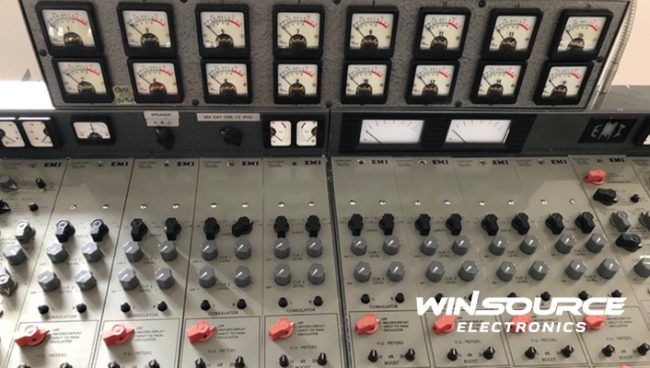
In the realm of audio technology, few advancements have had as profound an impact as the emergence of Electromagnetic Interference (EMI) audio.
Over the years, EMI audio has become synonymous with both the challenges and the innovative solutions that have propelled the field forward.
From its early days fraught with technical limitations to its current state as a cornerstone of high-fidelity sound reproduction, the journey of EMI audio is one defined by relentless innovation …overcoming obstacles, and transforming the way we experience sound.
As expert component providers here at WIN SOURCE, here’s a quick answer, and then we’ll get into more details. Or, visit our store to buy EMI Audio reduction products.
EMI audio, stemming from electromagnetic interference, has shaped audio technology’s evolution. From historical challenges to modern solutions, it’s spurred innovations in shielding, grounding, and digital advancements. Its impact spans industries, driving a continuous quest for interference-free sound.
Let’s get into more details, starting with a general understanding of EMI Audio…
Understanding EMI Audio
EMI audio refers to the interference caused by electromagnetic signals on audio devices, leading to unwanted noise, distortion, or disruptions in sound quality.
These interferences often arise from various sources such as power lines, electronic devices, radio frequency transmissions, or even natural phenomena like lightning strikes.
In the early stages of audio technology, EMI was a significant issue. It plagued audio equipment and limited the fidelity of sound reproduction.
These interferences manifested as static, hums, or buzzing sounds, compromising the purity of recorded or transmitted audio.
Historical Perspectives: EMI Challenges and Solutions
The inception of audio recording and transmission faced significant hurdles due to EMI.
Pioneers like Thomas Edison, Alexander Graham Bell, and Guglielmo Marconi encountered challenges in pursuing high-quality sound without interference. Edison’s phonograph, Bell’s telephone, and Marconi’s radio grappled with EMI issues, prompting engineers and scientists to seek solutions.
Advancements in technology led to the development of shielding techniques, better grounding methods, and the refinement of circuitry to mitigate EMI.
Additionally, the advent of vacuum tubes and later transistors facilitated significant improvements in audio device design, reducing susceptibility to interference and enhancing overall performance.
EMI in the Modern Era
In the modern era, we believe the evolution of audio technology has seen a period of continuous innovation aimed at minimizing EMI.
Along with the digital revolution, the landscape of audio recording, transmission, and playback underwent a radical transformation.
We witnessed analog technologies give way to digital formats, allowing for greater precision and control over audio signals.
However, digital audio brought its own set of challenges regarding EMI.
While immune to some traditional interference, digital systems introduced new vulnerabilities due to their reliance on sensitive electronic components and intricate signal processing methods.
As a result, engineers had to devise sophisticated strategies to combat EMI in digital audio interfaces, cables, and devices.
Now, let’s look at the EMI Audio Mitigation Techniques.
EMI Mitigation Techniques
To counteract EMI, engineers employ a plethora of techniques. Shielding, both within devices and in cables, helps contain electromagnetic fields. Grounding systems ensure that excess electrical charge dissipates harmlessly.
Ferrite beads, filters, and twisted pair wiring are among the various tools used to minimize interference.
Additionally, adherence to stringent electromagnetic compatibility (EMC) standards has become paramount in the design and manufacturing of audio equipment.
So how are these types of products used? Next, we’ll offer some typical applications.
EMI Audio and Industry Applications
EMI audio’s impact extends across numerous industries. In professional audio production, ensuring pristine sound quality is imperative. Studios invest in EMI-shielded rooms, high-quality cabling, and meticulously designed equipment to maintain audio fidelity.
In broadcast and telecommunications, where uninterrupted transmission is vital, EMI mitigation is a cornerstone of reliable communication systems.
Moreover, consumer electronics have greatly benefited from EMI suppression.
From smartphones to home entertainment systems, manufacturers strive to deliver interference-free audio experiences to end-users.
Portable devices, in particular, present unique challenges due to their compact designs, requiring innovative approaches to EMI reduction without compromising performance.
The Future of EMI Audio
Looking ahead, the pursuit of flawless audio reproduction continues to drive technological innovation. Advancements in materials science, signal processing, and miniaturization offer promising avenues for further EMI reduction.
Additionally, emerging technologies like wireless audio and Internet of Things (IoT) devices pose new challenges and opportunities in the realm of EMI mitigation.
Furthermore, the push for sustainability in electronics manufacturing calls for environmentally friendly materials and production processes, which may influence future EMI mitigation strategies.
EMI Audio – The End
EMI audio has evolved from a significant challenge in the early days of audio technology to a domain where constant innovation and ingenuity prevail.
The journey of mitigating electromagnetic interference in audio systems reflects the remarkable progress made in engineering, science, and the pursuit of superior sound quality.
As technology advances and new challenges arise, the quest for pristine, interference-free audio experiences will undoubtedly persist, driving the relentless pursuit of innovative solutions in the ever-evolving world of EMI audio.
To purchase EMI Audio mitigating products, visit our store or contact us for all your component needs.
© 2024 Win Source Electronics. All rights reserved. This content is protected by copyright and may not be reproduced, distributed, transmitted, cached or otherwise used, except with the prior written permission of Win Source Electronics.

COMMENTS